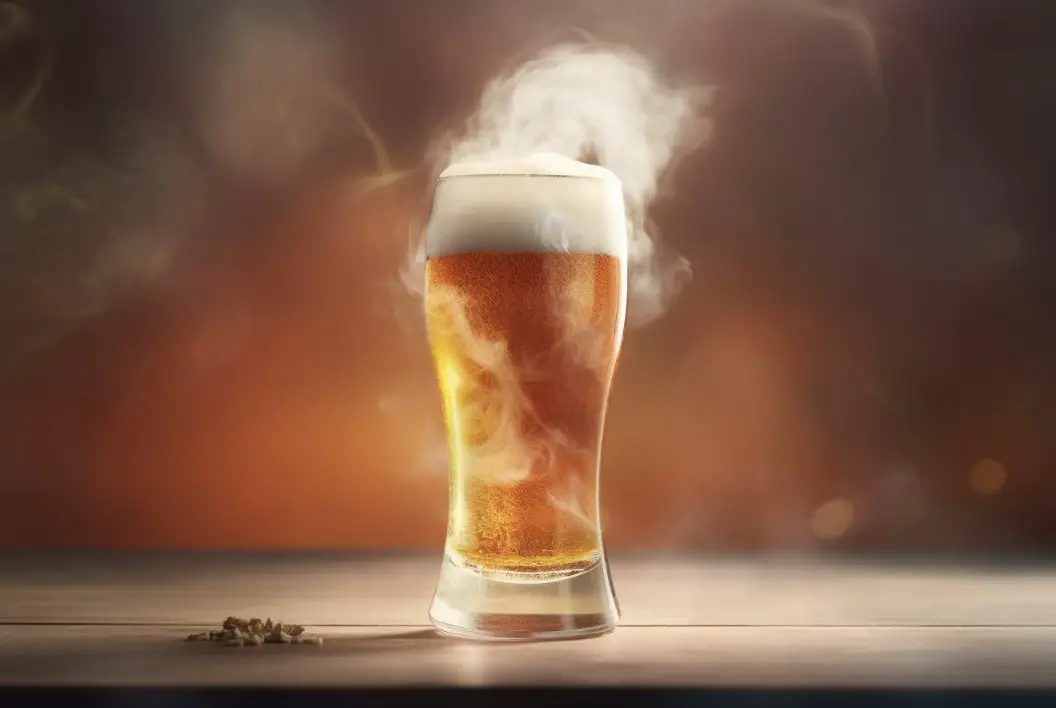When it comes to brewing cider, one of the most crucial factors that contribute to the taste and quality of the final product is the secondary fermentation temperature.
This is the phase where the majority of the aging takes place and the cider’s flavor profile is developed. So, what is the best cider secondary fermentation temperature?
The optimal cider secondary fermentation temperature lies within the range of 50-60°F (10-15°C).
This range allows for a slow and steady fermentation process, leading to a cider with a well-rounded flavor and smooth finish.
Understanding the Fermentation Process
Before we delve into the specifics of secondary fermentation, it’s important to understand the basic fermentation process. Fermentation is the metabolic process where yeast consumes the sugar in the apple juice, producing alcohol, carbon dioxide, and heat as a byproduct.
Primary Fermentation
The first part of the fermentation process is known as primary fermentation. This typically lasts for about a week and is where most of the alcohol is produced.

During this phase, the yeast is extremely active and produces a lot of heat. This is why it’s essential to keep the cider in a cool place, as the heat produced by the yeast can cause the temperature to rise significantly.
Secondary Fermentation
Following primary fermentation is the secondary fermentation phase. This is the stage where the yeast activity slows down, and the flavors of the cider begin to develop. The yeast consumes the remaining sugars, creating more alcohol and carbon dioxide.

This phase can last anywhere from a few weeks to several months, depending on the desired taste and alcohol content of the cider.
Importance of Temperature in Secondary Fermentation
The temperature during secondary fermentation plays a crucial role in the final taste and quality of the cider. If the temperatures are too high, the yeast can become overly active, leading to off-flavors and a harsh alcohol taste.

On the other hand, if the temperatures are too low, the yeast may become dormant and cease fermentation prematurely.
The Ideal Secondary Fermentation Temperature
As previously mentioned, the optimal cider secondary fermentation temperature lies within the range of 60-70°F (15-21°C). This range allows for a slow and steady fermentation process, leading to a cider with a well-rounded flavor and smooth finish.
How to Control Fermentation Temperature
There are several ways you can control the temperature during secondary fermentation to ensure it stays within the desired range. Some popular methods include using a temperature-controlled fridge or fermenting chamber, using a heat wrap or belt, or using a water bath.
Factors That Influence the Optimal Fermentation Temperature
Several factors can influence the fermentation temperature, including the type of yeast used, the initial temperature of the apple juice, and the ambient temperature of the room where the cider is being fermented.
Therefore, it’s essential to monitor the temperature regularly and adjust as necessary.
Several factors can influence fermentation temperature, including:
- Microorganism Type: Different microorganisms, such as yeast and bacteria, have specific temperature ranges at which they thrive. Some prefer cooler temperatures, while others perform better in warmer conditions.
- Microorganism Strain: Within a particular type of microorganism, different strains may have varying temperature preferences. Selecting the appropriate strain is essential to achieve the desired fermentation characteristics.
- Desired Product Characteristics: The flavor, aroma, and texture of the final product can be influenced by the fermentation temperature. For example, higher temperatures in brewing can lead to more fruity and estery flavors, while lower temperatures can result in cleaner and crisper profiles.
- Enzyme Activity: Many fermentation processes involve the action of enzymes. Temperature can affect enzyme activity, impacting the rate and efficiency of the fermentation process.
- Rate of Fermentation: Higher temperatures generally lead to faster fermentation rates, while lower temperatures slow down the process. The choice of temperature can affect production timelines.
- Yeast Growth and Reproduction: Yeast growth and reproduction can be influenced by temperature. Optimal temperature ranges promote healthy yeast growth and reduce the risk of off-flavors.
- Heat Generation: Fermentation is an exothermic process, meaning it generates heat. The temperature of the environment can affect how much heat is generated and whether external cooling or heating is necessary to maintain the desired temperature.
- Equipment and Infrastructure: The equipment used for fermentation can influence temperature control. Some setups are better equipped for maintaining stable temperatures than others.
- Ambient Temperature: The temperature of the surrounding environment can impact fermentation. Inconsistent ambient temperatures can lead to fluctuations in the fermentation process.
- Insulation: The level of insulation in the fermentation vessel or environment can affect temperature stability. Well-insulated vessels may be better at maintaining a constant temperature.
- Cooling and Heating Methods: The methods used to cool or heat the fermentation vessel can impact temperature control. Refrigeration, cooling jackets, immersion heaters, and other methods can be employed.
- Contamination Risk: Temperature can influence the risk of unwanted microbial contamination. Fermenting at temperatures outside the recommended range can create conditions that encourage the growth of spoilage microorganisms.
- Safety Considerations: Extremely high temperatures can lead to thermal stress on microorganisms, potentially killing them. Safety measures must be taken to prevent detrimental temperature extremes.
To achieve the desired fermentation outcome, it’s crucial to understand the specific requirements of the microorganisms involved, the goals for the final product, and the equipment and infrastructure available. Monitoring and controlling fermentation temperature accurately are essential for producing consistent and high-quality results.
Conclusion
In conclusion, the secondary fermentation temperature plays a vital role in the overall taste and quality of the cider. By maintaining the temperature within the optimal range of 60-70°F (15-21°C), you can ensure a slow and steady fermentation process, resulting in a well-rounded and flavorful cider.
10 Facts About Cider Fermentation Temperature
1. The optimal cider secondary fermentation temperature is 60-70°F (15-21°C).
2. Temperature plays a crucial role in the taste and quality of the cider.
3. High fermentation temperatures can lead to off-flavors and a harsh alcohol taste.
4. Low fermentation temperatures can cause the yeast to become dormant and cease fermentation prematurely.
5. The fermentation temperature can be controlled using various methods, such as a temperature-controlled fridge or fermenting chamber.
6. The type of yeast used can influence the fermentation temperature.
7. The initial temperature of the apple juice can also affect the fermentation temperature.
8. The ambient temperature of the room where the cider is being fermented can impact the fermentation temperature.
9. Regular monitoring and adjustment of the temperature is necessary during the entire fermentation process.
10. Maintaining the optimal temperature can result in a cider with a well-rounded flavor and smooth finish.
FAQs
What is the best temperature for secondary fermentation?
The best temperature for secondary fermentation depends on the specific beer style, yeast strain, and desired flavor profile. In general, a temperature range of 18-22°C (64-72°F) is commonly recommended. However, it is crucial to consult the specific yeast manufacturer’s guidelines and the recipe instructions for optimal results.
How long to leave cider in secondary fermentation?
The duration of secondary fermentation for cider can vary depending on personal preference and the desired flavor profile. Generally, it is recommended to leave cider in secondary fermentation for at least two weeks to allow for further clarification and flavor development. However, some cider makers may choose to extend this period to several months, especially if they are aiming for a more complex and mature taste. Ultimately, the length of secondary fermentation is subjective and can be adjusted based on individual taste preferences.
How long to leave cider in fermenter?
The duration for leaving cider in a fermenter can vary depending on the desired outcome and the specific recipe being used. In general, cider typically ferments for about 1 to 2 weeks. However, some cider makers may choose to leave it for a longer period, up to 4 weeks, to allow for more flavor development and clarification. It’s essential to monitor the fermentation process by checking the specific gravity and taste regularly to determine when it has reached the desired level of sweetness and flavor.
Can you ferment cider for too long?
Yes, you can ferment cider for too long. Over-fermentation can result in the production of excessive amounts of alcohol, leading to a higher alcohol content and potentially altering the flavor profile of the cider. It is important to monitor the fermentation process and stop it at the desired level of sweetness and alcohol content to achieve the desired taste.
What temperature is best for fermenting cider?
The best temperature for fermenting cider typically ranges between 60°F (15°C) and 75°F (24°C). This temperature range allows for optimal yeast activity and flavor development.
What is the ideal temperature for secondary fermentation?
The ideal temperature for secondary fermentation depends on the specific type of beverage being fermented. For most beers, a temperature range of 18-22°C (64-72°F) is commonly recommended. However, some styles may require slightly cooler or warmer temperatures. For wine, the range typically falls between 13-18°C (55-65°F). It’s important to consult the specific recipe or guidelines for the beverage you are fermenting to determine the ideal temperature for secondary fermentation.




